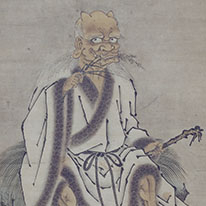Past Exhibitions
- Feature Exhibition: Olympia Meets Japanese Art
- June 5, 2021 - July 4, 2021
The Kyoto National Museum is pleased to present treasures from its collection to compare and contrast the ancient Olympics in Greece and religious folkways in Japan. The people of ancient Greece worshipped many gods and goddesses, and among the famous Panhellenic Games held to honor their deities, the most important and famous were the games held every four years at Olympia. Sacred ground to all Greeks, Olympia was a center of religious worship and the location of a magnificent temple to Zeus, lord of the heavens and almighty in the Greek pantheon. The athletes who competed at Olympia trained their minds and bodies to compete before these gods. The victors were feasted for days on end and gained the right to dedicate a statue of themselves on the temple grounds. In their home communities they were honored for the rest of their lives.
Like the ancient Greeks, Japanese since distant antiquity worshipped many deities, competed with each other in the presence of the divine, trained themselves mind and body, celebrated their victories, and feasted together with their gods.
This exhibit introduces art of Japan and East Asia that resonates with the stories and legends of the ancient Olympics, creating what we hope will be an opportunity to enjoy the arts of Asia while learning more about the world of ancient Greece.
6. Training
The competitors at the ancient Olympics were people who were blessed with both strong minds and healthy bodies and unstinting in their efforts to improve themselves. In East Asia as well, some pursued rigorous training to become sennin "immortals"—beings with extraordinary powers. The followers of Shugendō asceticism were people who engaged in strict training regimens in the mountains, where they sought to attain the capacities of "immortals" and deities.
The competitors of ancient Greece, meanwhile, placed their trust in medicine, pharmacology, nutrition, and dream oracles, placing everything in their lives on the line for the sake of victory. From one month before the main event they would go into training at Olympia to get their bodies into the best-possible shape. The training camp-like month served as the preliminary competition, in which those not qualified for the games were quickly eliminated. It is said that doctors and oracles were assigned to be in regular attendance.
Looking at the Kongō Rikishi guardian statues at the gates of Buddhist temples in Japan with their rippling musculature, the portrait of the deity of medicine, the Yume no ki (Dream Record) of the priest Myōe (1173–1232), images of richly idiosyncratic "immortals" and the assembly of delicious-looking Kyoto vegetables mourning a "daikon Buddha," let us imagine the feelings of the Olympic competitors before the games begin.












